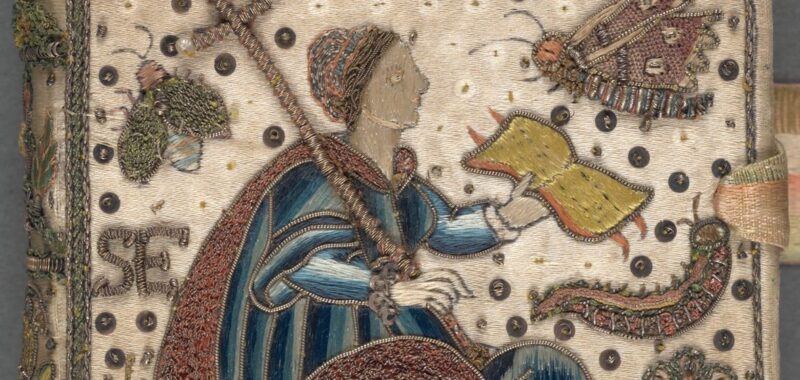Textiles become prints and prints become textiles in Line & Thread, a new exhibition at the New York Public Library’s Stephen A. Schwarzman Building. Across parallel walls and in display cases, a selection of historical pieces and artworks by modern and contemporary artists comes together to reveal the free-flowing cross-pollination between the two forms.
The overlaps between these modes of making have deep roots, in both the etymological and horticultural senses. Cotton, harvested and spun into thread to make fabric or beaten into pulp to make paper, has long been an important plant for print and textile production. And, as a wall label explains, the words “text” and “textile” both stem from the Latin word texere, which means “to weave.”
It is a joy to discover the interconnected thematic threads amongst the artworks in the exhibition, which line the third-floor hallway-gallery of the Rayner Special Collections Wing. On one end of the periwinkle-painted hall, a tidy assortment of historical pieces in a largely sepia palette showcases early examples of the blending of printing and textile arts, such as embroidered books and etchings with appliquéd silk.
Stroll through the rest of the space, and you’ll see hit after hit in an eclectic selection of more-recent artworks: an artist’s book by Faith Ringgold (“Seven Passages to a Flight,” 1995); a dress by designer Graham Baldwin printed with archival imagery sourced from the library’s nearby Pforzheimer Collection; folios from a collection by Sonia Delaunay (c. 1925); prints by Kiki Smith, Sanford Biggers, and Anni Albers, among others. Groupings include art prints that incorporate hand stitching, prints as textiles (and textiles as prints), artist’s books, and meditations on clothing and mending. Together, the works converse in texture and technique, thread and ink.

The visual languages of collage and quilt show up in several works. In Gee’s Bend quilter Loretta Pettway’s etching-and-aquatint piece “Remember Me” (2006), made in collaboration with Paulson Fontaine Press in San Francisco, gorgeous jewel tones saturate the paper. An abstract arrangement of rectangles meanders across the page — a quilt rendered in print, a home textile turned into an art object. In “Arrival” (2023), an assemblage of vivid, fabric-like patterns printed on Japanese paper with a Risograph machine and sewn with zig-zag stitching and dangling threads, artist Jacquelyn Strycker gleefully toys with perception. By playing up the amorphous qualities of paper and fabric and melding the outputs of a sewing machine and a piece of retro office equipment, her artwork could be seen as a quilt itself, a print of a quilt, or a collage — something not easily hemmed into a single realm of making.
A boundary-busting spirit bubbles at the cauldron heart of the show. Within the hallowed halls of this historic research library, renowned for housing extensive archives and books (and both are quintessential examples of textiles and print united, across printed pages and covers and collections) this show feels right at home. Both embracing tradition and shedding its confines, Line & Thread invites imagination and experimentation, offering a peek at what happens when ideas, materials, and creative processes collide and recombine, when lines meander and threads tangle in unexpected ways.

Line & Thread: Prints and Textiles from the 1600s to the Present continues at the New York Public Library’s Stephen A. Schwarzman Building in the Rayner Special Collections Wing (Fifth Avenue and 42nd Street, Manhattan) through January 12, 2025. Madeleine Viljoen curated the exhibition.

